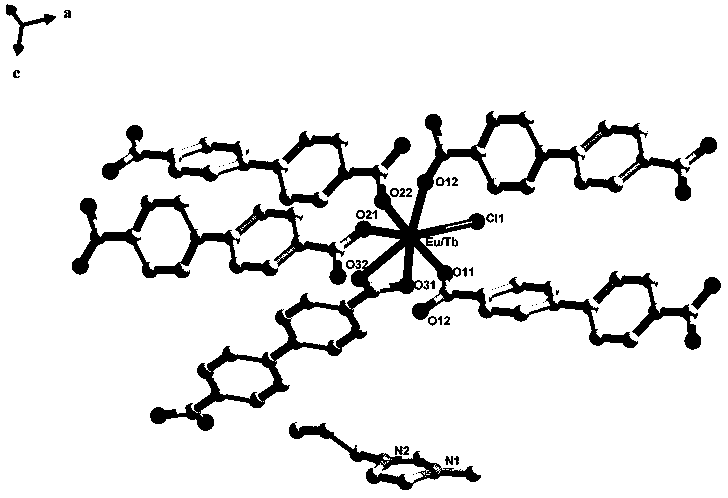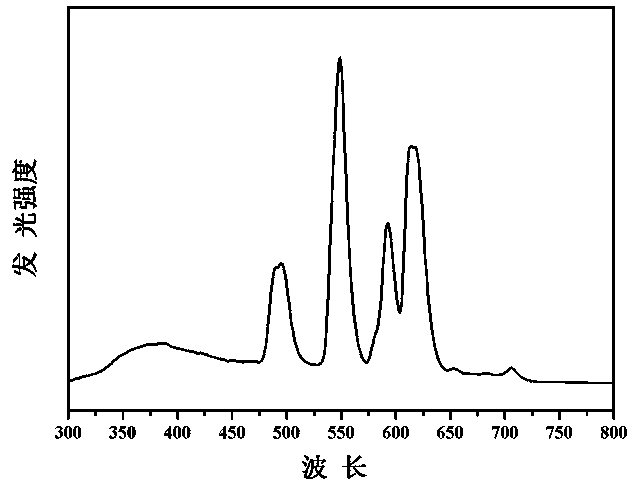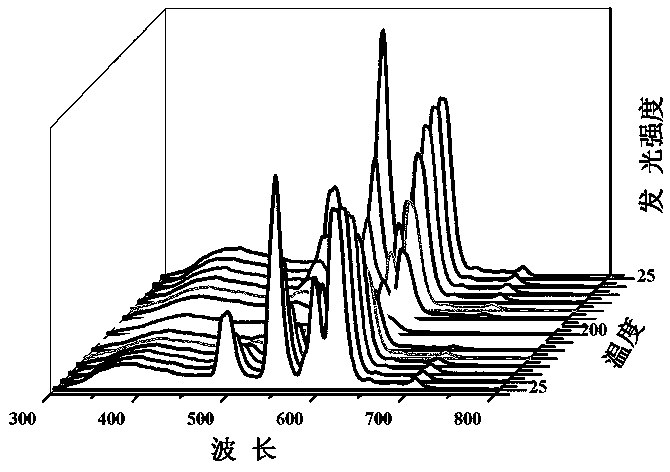Three europium-terbium co-doped fluorescent probes based on different carboxylic acid ligands and application of film in temperature sensing
A fluorescent probe, europium and terbium technology, applied in the field of temperature sensing, can solve the problems of different fluorescence quenching efficiencies
- Summary
- Abstract
- Description
- Claims
- Application Information
AI Technical Summary
Problems solved by technology
Method used
Image
Examples
Embodiment 1
[0038] 0.00785g (0.0214 mmol) EuCl 3 ·6H 2 O, 0.5521 g (1.478 mmol) of TbCl 3 ·6H 2 O, 0.0646 g (0.25 mmol) of 4,4´-dicarboxydiphenyl ether and 0.8 mL of 1-butyl-3-methylimidazolium iodide ionic liquid were added to a 25 mL Teflon-lined reactor and mixed well , then put the reaction kettle in an oven, react at 180 ℃ for 3 days, cool to room temperature, wash with acetone and ethanol, and obtain a colorless and transparent hexagonal Co-doped fluorescent probes. Such as figure 1 As shown, its structural unit is [Eu 0.0143 Tb 0.9857 (OBA)(H 2 O)Cl], where OBA represents the 4,4´-dicarboxydiphenylether root that has lost protons on the two carboxyl groups. The fluorescent probe belongs to the monoclinic crystal system, and the space group is P 2 1 / n, a = 15.3579Å, b = 11.1607Å, c = 8.4026Å, α = γ = 90°, β = 97.739(1)°, V = 1427.13Å 3 , Z=4.
[0039] The inventors used the solid-state fluorescence detection method to excite the above-mentioned fluorescent probes at 280n...
Embodiment 2
[0042] Fully grind 0.0150g of the 4,4´-dicarboxydiphenyl ether-europium-terbium co-doped fluorescent probe obtained in Example 1, weigh 0.0080g of maltose-modified polylactic acid, put it in a 7mL glass vial, and stir for half an hour After the maltose-modified polylactic acid is completely dissolved, add the ground sample into the maltose-modified polylactic acid solution and continue to stir for ten minutes. Use a dropper to absorb the solution and drop it on a glass plate to dry naturally to obtain Diphenyl ether-europium and terbium co-doped probe films.
Embodiment 3
[0044] Application of 4,4'-dicarboxydiphenyl ether-europium and terbium co-doped fluorescent probe film for temperature sensing in Example 2
[0045] 1. Iron plate simple analog temperature sensor
[0046] The 4,4´-dicarboxydiphenyl ether-europium-terbium co-doped fluorescent probe film was placed on the iron plate to form a simple analog temperature sensor. Use a lighter to heat the fluorescent probe film on the iron plate, and irradiate it with an ultraviolet lamp to observe the luminescent phenomenon of the fluorescent probe film. The initial fluorescent probe film emits relatively strong yellow light. After heating for about 18 seconds, the yellow light emitted by the analog temperature sensor gradually weakens until it finally turns green; then, remove the lighter and continue to use the ultraviolet lamp After irradiation, the green light emitted by the analog temperature sensor on the iron plate slowly returns to the original yellow color. This recovery process takes a...
PUM
| Property | Measurement | Unit |
|---|---|---|
| unit cell volume | aaaaa | aaaaa |
Abstract
Description
Claims
Application Information
 Login to View More
Login to View More - R&D
- Intellectual Property
- Life Sciences
- Materials
- Tech Scout
- Unparalleled Data Quality
- Higher Quality Content
- 60% Fewer Hallucinations
Browse by: Latest US Patents, China's latest patents, Technical Efficacy Thesaurus, Application Domain, Technology Topic, Popular Technical Reports.
© 2025 PatSnap. All rights reserved.Legal|Privacy policy|Modern Slavery Act Transparency Statement|Sitemap|About US| Contact US: help@patsnap.com



